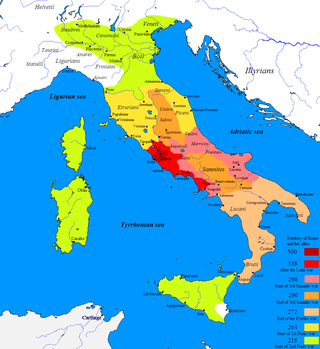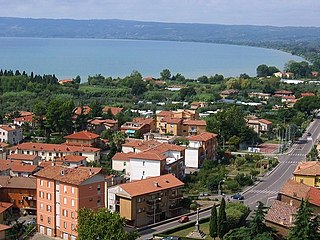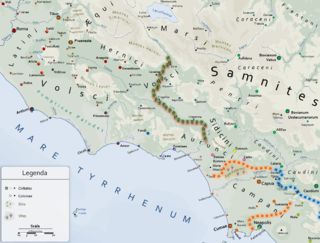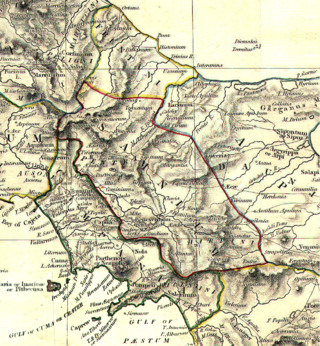Related Research Articles

The Osci were an Italic people of Campania and Latium adiectum before and during Roman times. They spoke the Oscan language, also spoken by the Samnites of Southern Italy. Although the language of the Samnites was called Oscan, the Samnites were never referred to as Osci, nor were the Osci called Samnites.

The First, Second, and Third Samnite Wars were fought between the Roman Republic and the Samnites, who lived on a stretch of the Apennine Mountains south of Rome and north of the Lucanian tribe.
Ausona was a 4th-century BC city in the central Italian region of Latium. It was one of the three cities possessed by the tribe of the Ausones and its name seems to imply that it was their chief city or metropolis. It is only once mentioned in history: during the Second Samnite War, when—the Ausones having revolted against the Romans—all three of their cities were betrayed into the hands of the Roman consuls, and their inhabitants put to the sword without mercy. No subsequent notice is found of Ausona; but it is supposed to have been situated on the banks of the little river still called Ausente, which flows into the Liris near its mouth. The plain below the modern village of Le Fratte, near the sources of this little stream, is still known as the Piano dell'Ausente; and some remains of a Roman town have been discovered there.

Volsinii or Vulsinii, is the name of two ancient cities of Etruria, one situated on the shore of Lacus Volsiniensis, and the other on the Via Clodia, between Clusium (Chiusi) and Forum Cassii (Vetralla). The latter was Etruscan and was destroyed by the Romans in 264 BC following an attempted revolt by its slaves, while the former was founded by the Romans using the remainder of the Etruscan population rescued from the razed city.

The Liri is one of the principal rivers of central Italy, flowing into the Tyrrhenian Sea a little below Minturno under the name Garigliano.
Monte Massico is a mountain situated in the Italian Province of Caserta (Campania) between the rivers Volturno and Garigliano.

Teano is a town and comune in the province of Caserta, Campania, southern Italy, 30 kilometres (19 mi) northwest of Caserta on the main line to Rome from Naples. It stands at the southeast foot of an extinct volcano, Rocca Monfina. Its St. Clement's cathedral is the see of the Roman Catholic Diocese of Teano-Calvi, which started as the Diocese of Teano circa AD 300.

Sessa Aurunca is a town and comune in the province of Caserta, Campania, southern Italy. It is located on the south west slope of the extinct volcano of Roccamonfina, 40 kilometres (25 mi) by rail west north west of Caserta and 30 kilometres (19 mi) east of Formia.

The Aurunci were an Italic tribe that lived in southern Italy from around the 1st millennium BC. They were eventually defeated by Rome and subsumed into the Roman Republic during the second half of the 4th century BC.

Avella is a town and comune in the province of Avellino, Campania, southern Italy.

Latium adiectum or Latium Novum was a region of Roman Italy between Monte Circeo and the river Garigliano, south of and immediately adjacent to Old Latium, hence its name of attached Latium.

"Ausones", the original name and the extant Greek form for the Latin "Aurunci", was a name applied by Greek writers to describe various Italic peoples inhabiting the southern and central regions of Italy. The term was used, specifically, to denote the particular tribe which Livy called the Aurunci, but later it was applied to all Italians, and Ausonia became a poetic term, in Greek and Latin, for Italy itself.

Eryx was an ancient city and a mountain of Magna Graecia in the west of Sicily, about 10 km from Drepana, and 3 km from the sea-coast. It was located at the site of modern Erice.
Bolae or Bola was an ancient city of Latium that was repeatedly mentioned in the early history of Rome. It was likely located in the territory of the modern town of Labico.
Sinuessa was a city of Latium, in the more extended sense of the name, situated on the Tyrrhenian Sea, about 10 km north of the mouth of the Volturno River. It was on the line of the Via Appia, and was the last place where that great highroad touched on the sea-coast. The ruins of the city are located in the modern-day municipality of Sessa Aurunca ,The hamlet is, as the crow flies, 12.24 Km from the Municipality of Sessa Aurunca and 41.43 Km from the Province of Caserta. It is 26.71 km from the regional capital (Naples/Napoli) Campania, Italy.
Suessa Pometia was an ancient city of Latium, which had ceased to exist in historical times. Although the modern city of Pomezia is named after it, the exact location of the ancient city is unknown.
Old Latium is a region of the Italian peninsula bounded to the north by the river Tiber, to the east by the central Apennine mountains, to the west by the Mediterranean Sea and to the south by Monte Circeo. It was the territory of the Latins, an Italic tribe which included the early inhabitants of the city of Rome. Later it was also settled by various Italic tribes such as the Rutulians, Volscians, Aequi, and Hernici. The region was referred to as "old" to distinguish it from the expanded region, Latium, that included the region to the south of Old Latium, between Monte Circeo and the river Garigliano – the so-called Latium adiectum. It corresponded to the central part of the modern administrative region of Lazio, Italy, and it covered an area measuring of roughly 50 Roman miles. It was calculated by Mommsen that the region's area was about 1860 square kilometres.

The Battle of Saticula, 343 BC, was the second of three battles described by the Roman historian Livy, in Book Seven of his history of Rome, Ab Urbe Condita, as taking place in the first year of the First Samnite War. According to Livy's extensive description, the Roman commander, the consul Aulus Cornelius Cossus was marching from Saticula when he was almost trapped by a Samnite army in a mountain pass. His army was only saved because one of his military tribunes, Publius Decius Mus, led a small group of men to seize a hilltop, distracting the Samnites and allowing the consul to escape. During the night Decius and his men were themselves able to escape. The next day the reunited Romans attacked the Samnites and completely routed them. Several other ancient authors also mention Decius' heroic acts. Modern historians are however sceptical of the historical accuracy of Livy's account, and have in particular noted the similarities with how a military tribune is said to have saved Roman army in 258 BC during the First Punic War.

The Sidicini were one of the Italic peoples of ancient Italy. Their territory extended northward from their capital, Teanum Sidicinum, along the valley of the Liri river up to Fregellae, covering around 3,000 square kilometres in total. They were neighbors of the Samnites and Campanians, and allies of the Ausones and Aurunci. Their language was a part of the Osco-Umbrian linguistic family.
The coinage of Suessa concerns coins minted in Suessa, a city in ancient Campania inhabited by the Aurunci, an ancient Italic population. The city minted coins in the period between 268 B.C. and the Second Punic War.
References
- Attribution
 This article incorporates text from a publication now in the public domain : Bunbury, Edward Hurbert (1854). "Aurunca". In Smith, William (ed.). Dictionary of Greek and Roman Geography . Vol. I. London: John Murray. p. 343.
This article incorporates text from a publication now in the public domain : Bunbury, Edward Hurbert (1854). "Aurunca". In Smith, William (ed.). Dictionary of Greek and Roman Geography . Vol. I. London: John Murray. p. 343.